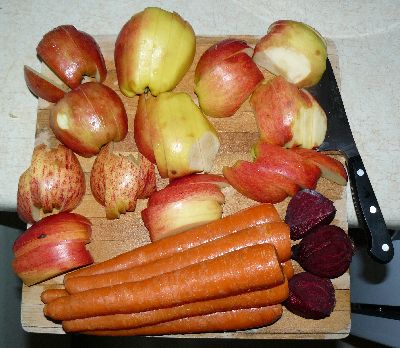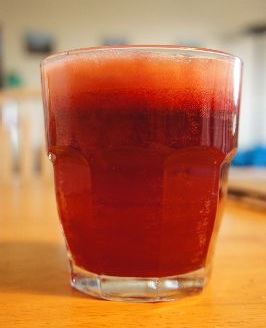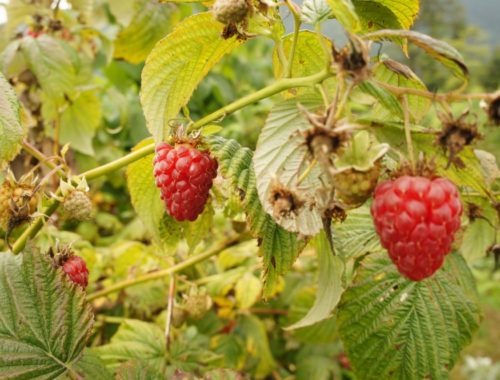
The ABC’s of Juicing

Several years ago Maya and I got a juicer for free from the pick-up area of our building (“where all good things come from”). For a long time it sat unused on our counter. Then we made hard apple cider with friends, from scratch. This was a lot of work, since the two home juicers we were using (one of them ours), kept on getting clogged every two cups of juice, and we had to juice over 20 liters! When the cider was ready, several weeks later, we weren’t too impressed, but a month later it was much better. However, we realized that we actually much preferred the apple juice itself. Somehow this realization in itself was not enough to spur us to start juicing.
For years Maya had been drinking a glass of boxed orange juice in the morning. Then I was somewhat shocked to read that store bought orange juice has a dirty secret. Having grown up drinking unlimited freshly squeezed orange juice, from oranges in an orchard on the village I grew up, I had noticed that the boxed stuff was different, but I didn’t realize how different, until I read this article (for more information, see the book Squeezed: What You Don’t Know About Orange Juice):
“…When the juice is stripped of oxygen it is also stripped of flavor providing chemicals. Juice companies therefore hire flavor and fragrance companies, the same ones that formulate perfumes for Dior and Calvin Klein, to engineer flavor packs to add back to the juice to make it taste fresh. Flavor packs aren’t listed as an ingredient on the label because technically they are derived from orange essence and oil. Yet those in the industry will tell you that the flavor packs, whether made for reconstituted or pasteurized orange juice, resemble nothing found in nature. The packs added to juice earmarked for the North American market tend to contain high amounts of ethyl butyrate, a chemical in the fragrance of fresh squeezed orange juice that, juice companies have discovered, Americans favor.”

So we started juicing, daily. We generally juice in the morning, as part of breakfast. My favourite is ABC juice: apple, beet and carrot. We’ve also tried celery, pears, oranges, strawberries, and haven’t delved yet into the world of juicing vegetables. In fact, a person who recently subletted our apartment told me he juices garlic and ginger, but that might be a bit too hard core for us.
Fresh juice is best drunk immediately after juicing, before it oxidizes, both to get the flavour of freshness and in order to get the full nutritional value. The difference in flavour between freshly made juice and store bought juice is striking.
Recently we visited friends and they showed us their masticating juicer, which costs around $350. I call it the Porsche of Juicers. While our juicer works by spinning at very high speeds (it sounds like an airplane) to force the juice out a sieve, this juicer “chews” on the fruit and vegetables, and has separate outputs for juice and pulp. The advantages include continuous operation (doesn’t clog), and the fact that it works with leaves as well. For now, we are content using our little airplane.



3 Comments
Nicole
Great post (like all of them!)
The pulp that comes out the other end is great for compost 🙂
I like our magimix juicer which has stood up well for a number of years to almost daily juicing.
Have found that if you put leaves in your juice, put them in first before or together with the hard veggies, and don’t use too many or your juice will have a layer of sediment.
Soft fruit like mango is (almost) un-juicable in our juicer and better used for smoothies.
The advantage of smoothies over juice is that the fiber is left in….
Zubromak Meniscus
I bought my first Champion juicer in 1976 and have never looked back. It is STILL today one of the best juicers on the market, and they last a lifetime! Put it in your will anfd leave for a loved one 🙂 Right now we have a perfectly good one my wife bought at a garage sale. Besides juicing, making apple sauce, it also makes the most mindblowing natural ice cream out of frozen fruit. Peel and freeze ripe bananas, strawberries, etc. Run them through the Champion and your life will forever be changed! Simple rock solid construction, the only maintenance after 30 years of using it is the need to sharpen the blade. Try adding a small clove of garlic to the carrot juice when feeling a cold coming on. http://youtu.be/_7quoGMsP7Y
http://www.greenhealthcanada.com/Champion_Juicer.html
Gili
Interesting, I never thought of running frozen fruit through the juicer! Good idea, I must try this soon. I wonder if our juicer can handle it though, it’s an old Krups model, probably not “one of the best juicers on the market”… Another way of making an ice cream substitute is to freeze slices of fruit and then whiz with some yoghurt in a food processor. The disadvantage compared with your method is that you need to slice the fruit, but I like the yoghurt flavour.